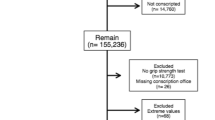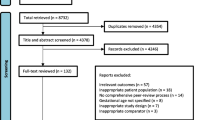Abstract
Objective
Lower muscle strength is associated with a range of adverse health outcomes in later life. The variation in muscle strength between individuals is only partly accounted for by factors in adult life such as body size and physical activity. The aim of this review was to assess the strength of the association between intrauterine development (indicated by birth weight) and subsequent muscle strength.
Design
Systematic review and meta-analysis of studies that assessed the association between birth weight and subsequent muscle strength.
Results
Nineteen studies met inclusion criteria with 17 studies showing that higher birth weight was associated with greater muscle strength. Grip strength was used as a single measure of muscle strength in 15 studies. Metaanalysis (13 studies, 20 481 participants, mean ages 9.3 to 67.5) showed a 0.86 kg (95% CI 0.58, 1.15) increase in muscle strength per additional kilogram of birth weight, after adjustment for age, gender and height at the time of strength measurement.
Conclusion
This review has found consistent evidence of a positive association between birth weight and muscle strength which is maintained across the lifecourse. Future work will be needed to elucidate the biological mechanisms underlying this association, but it suggests the potential benefit of an early intervention to help people maintain muscle strength in later life.
Similar content being viewed by others
References
Al Snih S, Markides KS, Ottenbacher KJ, Raji MA. Hand grip strength and incident ADL disability in elderly Mexican Americans over a seven-year period. Aging Clin Exp Res. 2004 Dec;16:481–486.
Sayer AA, Syddall HE, Martin HJ, Dennison EM, Anderson FH, Cooper C. Falls, sarcopenia, and growth in early life: findings from the Hertfordshire cohort study. Am J Epidemiol. 2006 Oct 1;164:665–671.
Sayer AA, Dennison EM, Syddall HE, Gilbody HJ, Phillips DI, Cooper C. Type 2 diabetes, muscle strength, and impaired physical function: the tip of the iceberg? Diabetes Care. 2005 Oct;28:2541–2542.
Cooper R, Kuh D, Hardy R, and the Mortality Review Group. Objectively measured physical capability levels and mortality: systematic review and meta-analysis. BMJ. 2010;341:c4467.
Inskip HM, Godfrey KM, Martin HJ, Simmonds SJ, Cooper C, Sayer AA, Southampton Women’s Survey Study Group. Size at birth and its relation to muscle strength in young adult women. J Intern Med. 2007 Sep;262:368–374.
Sayer AA, Cooper C, Evans JR, Rauf A, Wormald RP, Osmond C, Barker DJ. Are rates of ageing determined in utero? Age Ageing. 1998 Sep;27:579–583.
Kuh D, Bassey J, Hardy R, Sayer AA, Wadsworth M, Cooper C. Birth weight, childhood size, and muscle strength in adult life: evidence from a birth cohort study. Am J Epidemiol. 2002 Oct 1;156:627–633.
Sayer AA, Syddall HE, Gilbody HJ, Dennison EM, Cooper C. Does sarcopenia originate in early life? Findings from the Hertfordshire cohort study. J Gerontol A Biol Sci Med Sci. 2004 Sep;59:M930–M934.
Yliharsila H, Kajantie E, Osmond C, Forsen T, Barker DJ, Eriksson JG. Birth size, adult body composition and muscle strength in later life. Int J Obes (Lond). 2007 Sep;31:1392–1399.
Jensen CB, Storgaard H, Madsbad S, Richter EA, Vaag AA. Altered skeletal muscle fiber composition and size precede whole-body insulin resistance in young men with low birth weight. J Clin Endocrinol Metab. 2007 Apr;92:1530–1534.
Patel HP, Jameson KA, Syddall HE, Martin HJ, Stewart CE, Cooper C, Sayer AA. Developmental Influences, Muscle Morphology, and Sarcopenia in Community-Dwelling Older Men. J Gerontol A Biol Sci Med Sci. 2011 Feb 28; published online February 28, 2011 doi:10.1093/gerona/glr020.
Costello PM, Rowlerson A, Astaman NA, Anthony FE, Sayer AA, Cooper C, Hanson MA, Green LR. Peri-implantation and late gestation maternal undernutrition differentially affect fetal sheep skeletal muscle development. J Physiol. 2008 May 1;586:2371–2379.
Sayer AA, Syddall H, Martin H, Patel H, Baylis D, Cooper C. The developmental origins of sarcopenia. J Nutr Health Aging. 2008 Aug;12:427–432.
Centre for Reviews and Dissemination. Systematic reviews: CRD’s guidance for undertaking reviews in health care 2009. http://www.york.ac.uk/inst/crd/pdf/Systematic_Reviews.pdf. Accessed 01/10/2009. ed. 2009.
Stroup DF, Berlin JA, Morton SC, Olkin I, Williamson GD, Rennie D, Moher D, Becker BJ, Sipe TA, Thacker SB. Meta-analysis of observational studies in epidemiology: a proposal for reporting. Meta-analysis Of Observational Studies in Epidemiology (MOOSE) group. JAMA. 2000 Apr 19;283:2008–2012.
Moher D, Liberati A, Tetzlaff J, Altman DG. Preferred reporting items for systematic reviews and meta-analyses: the PRISMA statement. Ann Intern Med. 2009 Aug 18;151:264–269, W64.
Syddall H, Cooper C, Martin F, Briggs R, Aihie SA. Is grip strength a useful single marker of frailty? Age Ageing. 2003 Nov;32:650–656.
Ford GW, Kitchen WH, Doyle LW. Muscular strength at 5 years of children with a birthweight under 1500 g. Aust Paediatr J. 1988 Oct;24:295–296.
Barr JG, Veena SR, Kiran KN, Wills AK, Winder NR, Kehoe S, Fall CHD, Sayer AA, Krishnaveni GV. The relationship of birthweight, muscle size at birth and post-natal growth to grip strength in 9-year-old Indian children: findings from the Mysore Parthenon study. Journal of Developmental Origins of Health and Disease. 2010;1:329–337.
Egger M, Davey SG, Schneider M, Minder C. Bias in meta-analysis detected by a simple, graphical test. BMJ. 1997 Sep 13;315:629–634.
Martorell R, Ramakrishnan U, Schroeder DG, Melgar P, Neufeld L. Intrauterine growth retardation, body size, body composition and physical performance in adolescence. [Review] [25 refs]. Eur J Clin Nutr. 1998 Jan;52Suppl 1:S43–S52.
Kuzawa CW, McDade TW, Adair LS, Lee N. Rapid weight gain after birth predicts life history and reproductive strategy in Filipino males. Proc Natl Acad Sci U S A. 2010 Sep 28;107:16800–16805.
Duppe H, Cooper C, Gardsell P, Johnell O. The relationship between childhood growth, bone mass, and muscle strength in male and female adolescents. Calcif Tissue Int. 1997 May;60:405–409.
Ericson A, Kallen B. Very low birthweight boys at the age of 19. Arch Dis Child Fetal Neonatal Ed. 1998 May;78:F171–F174.
Ortega FB, Labayen I, Ruiz JR, Martin-Matillas M, Vicente-Rodriguez G, Redondo C, Warnberg J, Gutierrez A, Sjostrom M, et al. Are muscular and cardiovascular fitness partially programmed at birth? Role of body composition. J Pediatr. 2009 Jan;154:61–66.
Rogers M, Fay TB, Whitfield MF, Tomlinson J, Grunau RE. Aerobic capacity, strength, flexibility, and activity level in unimpaired extremely low birth weight (⇐ 800 g) survivors at 17 years of age compared with term-born control subjects. Pediatrics. 2005 Jul;116:E58–E65.
Small E, Bar-Or O, Van ME, Saigal S. Muscle function of 11- to 17-year-old children of extremely low birthweight. Pediatric Exercise Science. 1998;10:327–336.
Pitcher JB, Robertson AL, Cockington RA, Moore VM. Prenatal growth and early postnatal influences on adult motor cortical excitability. Pediatrics. 2009 Jul;124:e128–e136.
Ridgway CL, Ong KK, Tammelin T, Sharp SJ, Ekelund U, Jarvelin M-R. Birth size, infant weight gain, and motor development influence adult physical performance. Medicine and Science in Sports and Exercise. 2009 Jun;41:1212–1221.
Ridgway CL, Sharp SJ, Derom C, Beunen G, Fagard R, Vlietinck R, Ekelund U, Loos RJ. The contribution of prenatal environment and genetic factors to the association between birth weight and adult grip strength. PLoS One. 2011;6:e17955.
Saigal S, Szatmari P, Rosenbaum P, Campbell D, King S. Cognitive abilities and school performance of extremely low birth weight children and matched term control children at age 8 years: a regional study. J Pediatr. 1991 May;118:751–760.
te Velde SJ, Twisk JW, Van MW, Kemper HC. Birth weight and musculoskeletal health in 36-year-old men and women: results from the Amsterdam Growth and Health Longitudinal Study. Osteopor International. 2004 May;15:382–388.
Robinson SM, Jameson KA, Batelaan SF, Martin HJ, Syddall HE, Dennison EM, Cooper C, Sayer AA, Hertfordshire Cohort Study Group. Diet and its relationship with grip strength in community-dwelling older men and women: the Hertfordshire cohort study. J Am Geriatr Soc. 2008 Jan;56:84–90.
Saigal S, Stoskopf B, Boyle M, Paneth N, Pinelli J, Streiner D, Goddeeris J. Comparison of current health, functional limitations, and health care use of young adults who were born with extremely low birth weight and normal birth weight. Pediatrics. 2007 Mar;119:e562–e573.
Cooper R, Mishra G, Kuh D. Physical activity across adulthood and physical performance in mid-life: Findings from a British birth cohort study. Am J Prev Med. 2011;41:376–384.
Kuh D, Bassey EJ, Butterworth S, Hardy R, Wadsworth ME. Grip strength, postural control, and functional leg power in a representative cohort of British men and women: associations with physical activity, health status, and socioeconomic conditions. J Gerontol A Biol Sci Med Sci. 2005 Feb;60:224–231.
Roberts HC, Denison HJ, Martin HJ, Syddall HE, Patel HP, Cooper C, Sayer AA. A review of the measurement of grip strength in clinical and epidemiological studies: towards a standardised approach. Age Ageing. 2011;40:423–429.
Nahhas RW, Choh AC, Lee M, Chumlea WM, Duren DL, Siervogel RM, Sherwood RJ, Towne B, Czerwinski SA. Bayesian longitudinal plateau model of adult grip strength. Am J Hum Biol. 2010 Sep;22:648–656.
Rehfeldt C, Kuhn G. Consequences of birth weight for postnatal growth performance and carcass quality in pigs as related to myogenesis. J Anim Sci. 2006 Apr;84 Suppl:E113–E123.
Thompson CH, Sanderson AL, Sandeman D, Stein C, Borthwick A, Radda GK, Phillips DI. Fetal growth and insulin resistance in adult life: role of skeletal muscle morphology. Clin Sci (Lond). 1997 Mar;92:291–296.
Author information
Authors and Affiliations
Corresponding author
Rights and permissions
About this article
Cite this article
Dodds, R., Denison, H.J., Ntani, G. et al. Birth weight and muscle strength: A systematic review and meta-analysis. J Nutr Health Aging 16, 609–615 (2012). https://doi.org/10.1007/s12603-012-0053-9
Received:
Accepted:
Published:
Issue Date:
DOI: https://doi.org/10.1007/s12603-012-0053-9




